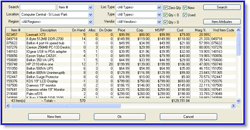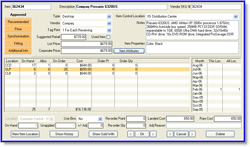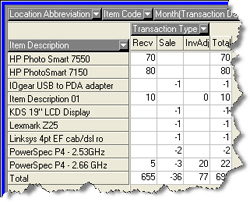Inventory Management
The IRIDIUM Retail Management Software tool enables inventory management based on inventory regions and locations, primary vendor, and inventory type. Detailed information on incoming orders, received items, and deliveries/pickups is displayed for each inventory item and is translated into allocations, purchases, and receivings.
When adding new inventory items to the system, the tool records detailed information for each new item, including: the unique item number/SKU; a text description of the item; the user-definable item type; the sale amount; suggested retail and corporate prices; the item weight; and the primary vendor User-definable item attributes (such as size and color) may be stored in the system and attached to each item. Default selections for printing item tags and specifying re-order points, re-order quantities, and cost adjustments are also available from this screen.
Inventory Costing
Several options for tracking item serial numbers are available from within the tool. The most comprehensive of method is to track serial numbers at every point inventory quantities are recorded, such as in receivings (for every item received) or when an item is sold and delivered (requiring the serial number to be selected from a comprehensive list).
For retailers who want to track serial numbers for items sold to customers, the system can be configured to require entry of the serial number at the time of customer possession. The last method simply prints a reminder on the invoice or delivery ticket instructing the delivery person to manually record the serial number on the document.
Inventory Costing
Costing of inventory within the system is calculated on an average cost basis, either by location or across all locations. When inventory is purchased, the total value of the inventory on the purchase order is added to the total value of the items currently in inventory. This value is then divided by the total number of units, and a new average cost value is generated.
Inventory History
A detailed inventory history may be generated for each inventory item. On-hand, allocated, and on-order inventory quantities may be broken down on a date-by-date, case-by-case basis.
Inventory Transaction Inquiry
Inventory inquiries for transactions created, sent, or received during a specified time frame may be generated as a means of inventory control. The tool categorizes every inventory transaction in one of three ways: (1) as an addition to the inventory, (2) a reduction in inventory, (3) or an adjustment to inventory. Additions to inventory occur with a new purchase, a used purchase, a transfer in, or a customer return. Reductions in inventory may be a sale, a transfer out, or a vendor return. Inventory adjustments account for cost adjustments or physical adjustments.
Inventory Stocking Levels
Each location for a given item has provisions for minimum stocking levels, with a pre-defined reorder quantity. These quantities are then used by the Purchasing System or the merchandise transfer process to help automate their creation. Each location can also have a total maximum value of inventory, preventing entry of merchandise transfers or purchase orders. This allows management to control the total value of inventory at each location.
Barcode Information
Items may also be selected for sale in the Inventory Management System by physically scanning a barcode or UPC symbol at the point of sale. Varying information, contained within the barcode or UPC symbol, may be configured to automatically populate the sales order and invoice fields within the tool.





